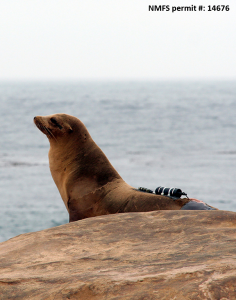Diving physiology and energetics of the California sea lion (in collaboration with Dr. Paul Ponganis)
 This project contributes to our understanding of oxygen management and the underlying physiological mechanisms of oxygen management in marine mammals. This information is essential if we are to interpret and understand the limits of dive performance, foraging ecology, and the ability of breath hold divers to adapt to environmental change and disturbance. In this study we will determine the rate and magnitude of oxygen store depletion during dives, and investigate its relationship to heart rate and workload, thereby improving our understanding of oxygen management during diving, specifically the role of lung oxygen stores and oxygen delivery to tissues.
This project contributes to our understanding of oxygen management and the underlying physiological mechanisms of oxygen management in marine mammals. This information is essential if we are to interpret and understand the limits of dive performance, foraging ecology, and the ability of breath hold divers to adapt to environmental change and disturbance. In this study we will determine the rate and magnitude of oxygen store depletion during dives, and investigate its relationship to heart rate and workload, thereby improving our understanding of oxygen management during diving, specifically the role of lung oxygen stores and oxygen delivery to tissues.
We used backpack digital recorders to measure blood oxygen depletion, heart rate, and flipper stroke rate in dives of California sea lions during maternal foraging trips to sea from San Nicolas Island. The goals of this research are: 1) determination of the rate, pattern and magnitude of blood oxygen store depletion during both shallow and deep dives at sea, 2) documentation of heart rate profiles of shallow and deep dives, and assessment of the relationship between changes in heart rate to blood oxygen profiles, and 3) documentation of flipper stroke rate profiles during shallow and deep dives, and assessment of the relationship of stroke rate to both changes in heart rate and changes in blood oxygen profiles. This data has been collected and Dr. McDonald is finishing up analysis.
This summer, Mason Cole will collect data on the feeding behavior and find scale diving behavior of California sea lions using accelerometers to improve our understanding of their foraging energetics.

